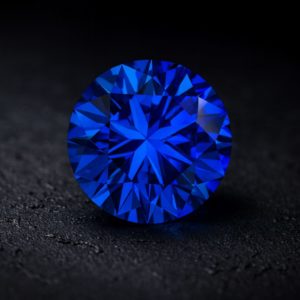SAPPHIRE

Whether natural or synthetic, sapphire is a highly prized material in watchmaking due to its hardness, clarity, and scratch resistance. In its synthetic form, sapphire is used mainly for watch crystals and, in recent decades, for the manufacture of partial or complete cases. Scratch-resistant and potentially colourless, synthetic sapphire has ultimately completely replaced mineral glass. Its use has revolutionised the watch industry, and its popularity has grown alongside advances in manufacturing technologies.
Natural sapphire
Like ruby, natural sapphire is a variety of corundum, a mineral composed of aluminium oxide. It is characterised by its exceptional hardness, reaching 9 on the Mohs scale, making it one of the most scratch-resistant materials after diamond. Natural sapphires are mined mainly from deposits in Asia, particularly Thailand, Sri Lanka, and Myanmar. Their colour can range from deep blue to shades of yellow, green, or pink, although blue remains the most iconic hue.
In watchmaking, natural sapphire is used exclusively for gem-setting in high-jewellery watches (dials, cases, bracelets).
Synthetic sapphire
Synthetic sapphire, by contrast, is manufactured in laboratories using processes such as the Verneuil method or hydrothermal growth. This material reproduces the properties of natural sapphire, especially its hardness and scratch resistance. Synthetic sapphires became popular in watchmaking in the 1990s, offering significant advantages in cost and availability while maintaining virtually identical characteristics to natural sapphire.
One of the major advantages of synthetic sapphire is its ability to be produced in large quantities at much more competitive prices. Unlike natural sapphire, which is extracted from sometimes hard-to-access deposits, synthetic sapphire can be manufactured in a controlled, homogeneous manner, making it more affordable and readily available. In watchmaking, synthetic sapphire is used for crystals, and increasingly, manufactures are offering partial or complete cases made from it. Beyond its transparency, synthetic sapphire can be coloured in various shades, and its low density makes it an extremely light and comfortable material.
Sapphire in watchmaking: Uses and advantages
Natural or synthetic sapphire is sought above all for its hardness. When used as a crystal, it protects the watch movement from wear and external damage and offers high scratch resistance. It is also valued for its aesthetics, as it provides absolute transparency.
Comparison of natural and synthetic sapphires
-
Price: Natural sapphire is generally more expensive due to its rarity and the complexity of its extraction. Synthetic sapphire is therefore more affordable while offering very similar, or even superior, characteristics (e.g. transparency, absence of inclusions).
-
Physical properties: Both types of sapphire have similar physical characteristics, notably hardness and scratch resistance. However, subtle differences exist in the purity of the materials and the presence of natural inclusions in natural sapphire, which can affect its transparency and make it more fragile than synthetic sapphire.
Conclusion
While natural sapphires have always held a place of honour in jewellery, synthetic sapphire has, since the mid-20th century, become an essential material for the manufacture of watch crystals and watch exteriors.
